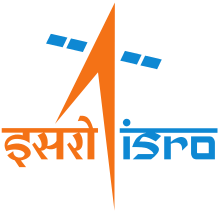Chandrayaan-2
Chandrayaan-2 (candra-yāna, transl. "mooncraft"; ![]()
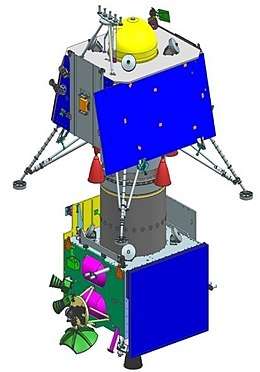 Chandrayaan-2 composite | |
| Mission type | Lunar orbiter, lander, rover |
|---|---|
| Operator | Indian Space Research Organisation (ISRO) |
| COSPAR ID | 2019-042A |
| SATCAT no. | 44441 |
| Website | www |
| Mission duration | |
| Spacecraft properties | |
| Manufacturer | Indian Space Research Organisation (ISRO) |
| Launch mass | Combined (wet): 3,850 kg (8,490 lb)[3][4][5] Combined (dry): 1,308 kg (2,884 lb)[6] Orbiter (wet): 2,379 kg (5,245 lb)[4][5] Orbiter (dry): 682 kg (1,504 lb)[6] Vikram lander (wet): 1,471 kg (3,243 lb)[4][5] Vikram lander (dry): 626 kg (1,380 lb)[6] Pragyan rover: 27 kg (60 lb)[4][5] |
| Power | Orbiter: 1 kW (1.3 hp)[7]
Vikram lander: 650 W[8] Pragyan rover: 50 W[8] |
| Start of mission | |
| Launch date | 22 July 2019, 14:43:12 IST (09:13:12 UTC)[9] |
| Rocket | GSLV Mark III M1[10][11] |
| Launch site | Satish Dhawan Space Centre Second Launch Pad |
| Contractor | Indian Space Research Organisation (ISRO) |
| Moon orbiter | |
| Orbital insertion | 20 August 2019, 09:02 IST (03:32 UTC)[12][13] |
| Orbital parameters | |
| Pericynthion altitude | 100 km (62 mi)[14] |
| Apocynthion altitude | 100 km (62 mi)[14] |
| Moon lander | |
| Spacecraft component | Rover |
| Landing date | 7 September 2019, 01:53 IST (failure) (6 September 2019, 20:23 UTC)[13][15] |
| Landing site | Lunar south pole (intended) |
The spacecraft was launched on its mission to the Moon from the second launch pad at the Satish Dhawan Space Centre in Andhra Pradesh on 22 July 2019 at 2.43 p.m. IST (09:13 UTC) by a GSLV Mark III M1. The craft reached the Moon's orbit on 20 August 2019 and began orbital positioning manoeuvres for the landing of the Vikram lander. The lander and the rover were scheduled to land on the near side of the Moon, in the south polar region at a latitude of about 70° south on 6 September 2019 and conduct scientific experiments for one lunar day, which approximates to two Earth weeks. A successful soft landing would have made India the fourth country after the Soviet Union, United States and China to do so.
However, the lander deviated from its intended trajectory while attempting to land on 6 September 2019 which caused a 'hard landing'. According to a failure analysis report submitted to ISRO, the crash was caused by a software glitch. ISRO may re-attempt a landing by the second quarter of 2021 with Chandrayaan-3.
History
On 12 November 2007, representatives of the Roscosmos and ISRO signed an agreement for the two agencies to work together on the Chandrayaan-1's follow-up project, Chandrayaan-2.[16][17] ISRO would have the prime responsibility for the orbiter and rover, while Roscosmos was to provide the lander. The Indian government approved the mission in a meeting of the Union Cabinet, held on 18 September 2008 and chaired by Prime Minister Manmohan Singh.[18] The design of the spacecraft was completed in August 2009, with scientists of both countries conducting a joint review.[19][20]
Although ISRO finalised the payload for Chandrayaan-2 on schedule,[21] the mission was postponed in January 2013 and rescheduled to 2016 because Russia was unable to develop the lander on time.[22][23][24] In 2012, there was a delay in the construction of the Russian lander for Chandrayaan-2 due of the failure of the Fobos-Grunt mission to Mars, since the technical issues connected with the Fobos-Grunt mission which were also used in the lunar projects including the lander for Chandrayaan-2 needed to be reviewed.[23] When Russia cited its inability to provide the lander even by 2015, India decided to develop the lunar mission independently.[22][25]
The spacecraft's launch had been scheduled for March 2018 initially after the India's decision, but was first delayed to April and then to October to conduct further tests on the vehicle.[26][27] On 19 June 2018, after the program's fourth Comprehensive Technical Review meeting, a number of changes in configuration and landing sequence were planned for implementation, pushing the launch to the first half of 2019.[28] Two of the lander's legs received minor damage during one of the tests in February 2019.[29]
Chandrayaan-2 launch was scheduled for 14 July 2019, 21:21 UTC (15 July 2019 at 02:51 IST local time), with the landing expected on 6 September 2019.[30] However, the launch was aborted due to a technical glitch and was rescheduled.[9][31][32] The launch occurred on 22 July 2019 at 09:13 UTC (14:43 IST) on the first operational flight of a GSLV MK III M1.[33]
On 6 September 2019, the lander during its landing phase, deviated from its intended trajectory starting at 2.1 kilometres (1.3 mi) altitude,[34] and had lost communication when touchdown confirmation was expected.[35][36] Initial reports suggesting a crash[37][38] were confirmed by ISRO chairman K. Sivan, stating that "it must have been a hard landing".[39] The Failure Analysis Committee concluded that the crash was caused by a software glitch.[40] Unlike ISRO's previous record, the report of the Failure Analysis Committee has not been made public.[41]
Objectives
The primary objectives of the Chandrayaan-2 lander were to demonstrate the ability to soft-land and operate a robotic rover on the lunar surface.
The scientific goals of the orbiter are:
- to study lunar topography, mineralogy, elemental abundance, the lunar exosphere, and signatures of hydroxyl and water ice[42][43]
- to study the water ice in the south polar region and thickness of the lunar regolith on the surface[44]
- to map the lunar surface and help to prepare 3D maps of it
Design
The name Chandrayaan means "mooncraft" in Sanskrit and Hindi.[45][46] The mission was launched on a Geosynchronous Satellite Launch Vehicle Mark III (GSLV Mk III) M1 with an approximate lift-off mass of 3,850 kg (8,490 lb) from Satish Dhawan Space Centre on Sriharikota Island of Andhra Pradesh.[3][11][14][47] As of June 2019, the mission has an allocated cost of ₹ 9.78 billion (approximately US$141 million) which includes ₹ 6 billion for the space segment and ₹ 3.75 billion as launch costs on GSLV Mk III M1.[48][49] Chandrayaan-2 stack was initially put in an Earth parking orbit of 170 kilometres (110 mi) perigee and 40,400 kilometres (25,100 mi) apogee by the launch vehicle.[50]
Orbiter
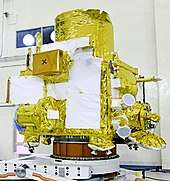
The Chandrayaan-2 orbiter is orbiting the Moon on a polar orbit at an altitude of 100 km (62 mi).[51] It carries eight scientific instruments; two of which are improved versions of those flown on Chandrayaan-1. The approximate launch mass was 2,379 kg (5,245 lb).[4][5][21][52] The Orbiter High Resolution Camera (OHRC) conducted high-resolution observations of the landing site prior to separation of the lander from the orbiter.[2][51] The orbiter's structure was manufactured by Hindustan Aeronautics Limited and delivered to the ISRO Satellite Centre on 22 June 2015.[53][54]
- Dimensions: 3.2 × 5.8 × 2.2 m[8]
- Gross lift-off mass: 2,379 kg (5,245 lb)[3]
- Propellant mass: 1,697 kg (3,741 lb)[6]
- Dry mass: 682 kg (1,504 lb)[6]
- Power generation capacity: 1000 W[8]
- Mission duration: approximately 7.5 years, extended from the planned 1 year owing to the precise launch and mission management, in lunar orbit[1][55]
Vikram lander
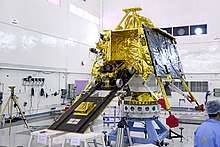
The mission's lander is called Vikram (Sanskrit: विक्रम, lit. 'Valour'[57]) ![]()
The preliminary configuration study of the lander was completed in 2013 by the Space Applications Centre (SAC) in Ahmedabad.[22] The lander's propulsion system consisted of eight 50 N (11 lbf) thrusters for attitude control and five 800 N (180 lbf) liquid main engines derived from ISRO's 440 N (99 lbf) liquid apogee motor.[59][60] Initially, the lander design employed four main throttle-able liquid engines, but a centrally mounted fixed-thrust engine[61] was added to handle new requirements of having to orbit the Moon before landing. The additional engine was expected to mitigate upward draft of lunar dust during the soft landing.[47] Vikram was designed to safely land on slopes up to 12°.[62][63]
Some associated technologies include a high resolution camera, Laser Altimeter (LASA),[64] Lander Hazard Detection Avoidance Camera (LHDAC), Lander Position Detection Camera (LPDC),[65] Lander Horizontal Velocity Camera (LHVC), an 800 N throttleable liquid main engine,[53] attitude thrusters, Ka band radio altimeters,[66][67] Laser Inertial Reference & Accelerometer Package (LIRAP),[68] and the software needed to run these components.[2][51] Engineering models of the lander began undergoing ground and aerial tests in late October 2016, in Challakere in the Chitradurga district of Karnataka. ISRO created roughly 10 craters on the surface to help assess the ability of the lander's sensors to select a landing site.[69][70]
Pragyan rover
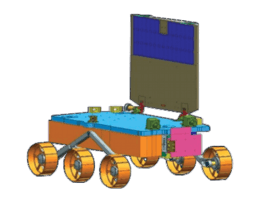
The mission's rover was called Pragyan (Sanskrit: प्रज्ञान, lit. 'Wisdom'[71][72]) ![]()
- Stereoscopic camera-based 3D vision: two 1 megapixel, monochromatic navcams in front of the rover to provide the ground control team a 3D view of the surrounding terrain, and help in path-planning by generating a digital elevation model of the terrain.[76] IIT Kanpur contributed to the development of the subsystems for light-based map generation and motion planning for the rover.[77]
- Control and motor dynamics: the rover has a rocker-bogie suspension system and six wheels, each driven by independent brushless DC electric motors. Steering is accomplished by differential speed of the wheels or skid steering.[78]
The expected operating time of Pragyan rover was one lunar day, or around 14 Earth days, as its electronics were not designed to endure the frigid lunar night. However, its power system has a solar-powered sleep/wake-up cycle implemented, which could have resulted in longer service time than planned.[79][80] Two aft wheels of the rover had the ISRO logo and the State Emblem of India embossed on them to leave behind patterned tracks on the lunar surface.[81][82]
Science payload

ISRO selected eight scientific instruments for the orbiter, four for the lander,[3][83][84] and two for the rover.[21] While it was initially reported that NASA and ESA would participate in the mission by providing some scientific instruments for the orbiter,[85] ISRO in 2010 had clarified that due to weight restrictions it will not be carrying foreign payloads on the mission.[86] However, in an update a month before launch,[87] an agreement between NASA and ISRO was signed to include a small laser retroreflector from NASA to the lander's payload to measure the distance between the satellites above and the microreflector on the lunar surface.[88][89]
Orbiter
Payloads on the orbiter are:[1][3][84]
- Chandrayaan-2 Large Area Soft X-ray Spectrometer (CLASS) from the ISRO Satellite Centre (ISAC), which makes use of X-ray fluorescence spectra to determine the elemental composition of the lunar surface[90]
- Solar X-ray monitor (XSM) from Physical Research Laboratory (PRL), Ahmedabad, for mapping the lunar surface[21][91]
- Dual Frequency L and S band Synthetic Aperture Radar (DFSAR) from the Space Applications Centre (SAC) for probing the first few metres of the lunar surface for the presence of different constituents. DFSAR was expected to provide further evidence confirming the presence of water ice, and its distribution below the shadowed regions of the Moon.[21][92] It has lunar surface penetration depth of 5 metres (16 ft) (L-band).[55][84]
- Imaging IR Spectrometer (IIRS) from the SAC for mapping of lunar surface over a wide wavelength range for the study of minerals, water molecules and hydroxyl present.[21][93] It featured an extended spectral range (0.8 μm to 5 μm), an improvement over previous lunar missions whose payloads worked up to 3 μm.[55][94][95]
- Chandrayaan-2 Atmospheric Compositional Explorer 2 (ChACE-2)[96] Quadrupole Mass Analyzer from Space Physics Laboratory (SPL) to carry out a detailed study of the lunar exosphere[21]
- Terrain Mapping Camera-2 (TMC-2) from SAC for preparing a three-dimensional map essential for studying the lunar mineralogy and geology[21][97]
- Radio Anatomy of Moon Bound Hypersensitive Ionosphere and Atmosphere – Dual Frequency Radio Science experiment (RAMBHA-DFRS) by SPL for the studying electron density in the lunar ionosphere[98]
- Orbiter High Resolution Camera (OHRC) by SAC for scouting a hazard-free spot prior to landing. Used to help prepare high-resolution topographic maps and digital elevation models of the lunar surface. OHRC had a spatial resolution of 0.32 metres (1 ft 1 in) from 100 kilometres (62 mi) polar orbit, which was the best resolution among any lunar orbiter mission to date.[84][99][100][101]
Vikram lander
The payloads on the Vikram lander were:[3][84]
- Instrument for Lunar Seismic Activity (ILSA) MEMS based seismometer by LEOS for studying Moon-quakes near the landing site[14][83][102][103]
- Chandra's Surface Thermo-physical Experiment (ChaSTE) thermal probe by SPL, Vikram Sarabhai Space Centre (VSSC) for estimating the thermal properties of the lunar surface[14]
- RAMBHA-LP Langmuir probe by SPL, VSSC for measuring the density and variation of lunar surface plasma[14][83]
- A laser retroreflector array (LRA) by the Goddard Space Flight Center for taking precise measurements of distance between the reflector on the lunar surface and satellites in lunar orbit.[87][88][104][105] The microreflector weighed about 22 grams and cannot be used for taking observations from Earth-based lunar laser stations.[88]
Pragyan rover
Pragyan rover carried two instruments to determine the abundance of elements near the landing site:[3][84]
- Laser induced Breakdown Spectroscope (LIBS) from the laboratory for Electro Optic Systems (LEOS), Bangalore[21][106]
- Alpha Particle Induced X-ray Spectroscope (APXS) from PRL, Ahmedabad[107][108][109]
Mission profile
Launch

The launch of Chandrayaan-2 was initially scheduled for 14 July 2019, 21:21 UTC (15 July 2019 at 02:51 IST local time).[30] However, the launch was aborted 56 minutes and 24 seconds before launch due to a technical glitch, so it was rescheduled to 22 July 2019.[9][31] Unconfirmed reports later cited a leak in the nipple joint of a helium gas bottle as the cause of cancellation.[32][110][111]
Finally Chandrayaan-2 was launched on board the GSLV MK III M1 launch vehicle on 22 July 2019 at 09:13 UTC (14:43 IST) with a better-than-expected apogee as a result of the cryogenic upper stage being burned to depletion, which later eliminated the need for one of the apogee-raising burns during the geocentric phase of mission.[33][112][113] This also resulted in the saving of around 40 kg fuel on board the spacecraft.[114]
Immediately after launch, multiple observations of a slow-moving bright object over Australia were made, which could be related to upper stage venting of residual LOX/LH2 propellant after the main burn.[115][116]
Geocentric phase

After being placed into a 45,475 × 169 km parking orbit by the launch vehicle,[33] the Chandrayaan-2 spacecraft stack gradually raised its orbit using on-board propulsion over 22 days. In this phase, one perigee-raising and five apogee-raising burns were performed to reach a highly eccentric orbit of 142,975 × 276 km[117] followed by trans-lunar injection on 13 August 2019.[118] Such a long Earth-bound phase with multiple orbit-raising manoeuvres exploiting the Oberth effect was required because of the limited lifting capacity of the launch vehicle and thrust of the spacecraft's on-board propulsion system. A similar strategy was used for Chandrayaan-1 and the Mars Orbiter Mission during their Earth-bound phase trajectory.[119] On 3 August 2019, the first set of Earth images were captured by the LI4 camera on the Vikram lander, showing the North American landmass.[56]
Selenocentric phase
After 29 days from its launch, the Chandrayaan-2 spacecraft stack entered lunar orbit on 20 August 2019 after performing a lunar orbit insertion burn for 28 minutes 57 seconds.[120] The three-spacecraft stack was placed into an elliptical orbit that passed over the polar regions of the Moon, with 18,072 km (11,229 mi) aposelene and 114 km (71 mi) periselene.[121] By 1 September 2019 this elliptical orbit was made nearly circular with 127 km (79 mi) aposelene and 119 km (74 mi) periselene after four orbit-lowering manoeuvres[122][123][124][125] followed by separation of Vikram lander from the orbiter on 7:45 UTC, 2 September 2019.[126]
Planned landing site
| Landing site[127] | Coordinates |
|---|---|
| Prime landing site | 70.90267°S 22.78110°E |
| Alternate landing site | 67.87406°S 18.46947°W |
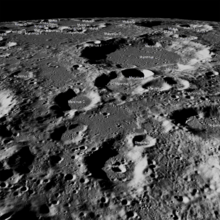
Two landing sites were selected, each with an ellipse of 32 by 11 kilometres (19.9 mi × 6.8 mi).[127] The prime landing site (PLS54) was at 70.90267°S 22.78110°E (600 km (370 mi) from the south pole[128]), and the alternate landing site (ALS01) was at 67.87406°S 18.46947°W. The prime site was on a high plain between the craters Manzinus C and Simpelius N,[129][130] on the near side of the Moon.
Loss of Vikram
Vikram began its descent at 20:08:03 UTC, 6 September 2019 and was scheduled to land on the Moon at around 20:23 UTC. The descent and soft-landing were to be performed by the on-board computers on Vikram, with mission control unable to make corrections.[131] The initial descent was considered within mission parameters, passing critical braking procedures as expected, but the lander's trajectory began to deviate at about 2.1 kilometres (1.3 mi; 6,900 ft) above the surface.[132][133] The final telemetry readings during ISRO's live-stream show that Vikram's final vertical velocity was 58 m/s (210 km/h) at 330 metres (1,080 ft) above the surface, which a number of experts noted, would have been too fast for the lunar lander to make a successful landing.[35][134][135] Initial reports suggesting a crash[37][38] were confirmed by ISRO chairman K. Sivan, stating that "it must have been a hard landing".[39][136][137]
Radio transmissions from the lander were tracked during descent by analysts using a 25-metre (82 ft) radio telescope owned by the Netherlands Institute for Radio Astronomy. Analysis of the doppler data suggests that the loss of signal coincided with the lander impacting the lunar surface at a velocity of nearly 50 m/s (180 km/h) (as opposed to an ideal 2 m/s (7.2 km/h) touchdown velocity).[3][138] The powered descent was also observed by NASA's Lunar Reconnaissance Orbiter (LRO) using its Lyman-Alpha Mapping Project instrument to study changes in the lunar exosphere due to exhaust gases from the lander's engines.[139] K. Sivan, tasked senior scientist P. S. Goel to head the Failure Analysis Committee to look into the causes of the failure.[140]
Both ISRO and NASA attempted to communicate with the lander for about two weeks before the lunar night set in,[101][141] while NASA's LRO flew over on 17 September 2019 and acquired some images of the intended landing zone.[142] However, the region was near dusk, causing poor lighting for optical imaging.[143][144] NASA's LRO images, showing no sight of the lander, were released on 26 September.[128] The LRO flew over again on 14 October under more favorable lighting conditions,[145][146] but was unable to locate it.[147][148] The LRO performed a third flyover on 10 November.[147]
On 16 November 2019, the Failure Analysis Committee released its report to the Space Commission, concluding that the crash was caused by a software glitch.[40] Phase One of descent from an altitude of 30 km to 7.4 km above the Moon's surface went as intended with velocity being reduced from 1,683 m/s to 146 m/s. But velocity reduction during the second phase of descent was more than expected. This deviation from nominal was beyond the designed parameters of on-board software,[149] causing Vikram to land hard, though it managed to impact relatively near the intended landing site.[150] The complete findings have not been made public.[151][152][153]
Vikram's impact site was located at 70.8810°S 22.7840°E by the LROC team after receiving helpful input from Shanmuga Subramanian, a volunteer from Chennai, Tamil Nadu, who located debris from the spacecraft in pictures released by NASA.[154][155] While initially estimated to be within 500 metres (1,600 ft) of the intended landing site, best-guess estimates from satellite imagery indicate initial impact about 600 m away.[156] The spacecraft shattered upon impact,[157] with debris scattered over almost two dozen locations in an area spanning kilometres.[155]
The orbiter part of the mission, with eight scientific instruments, remains operational, and will continue its seven-year mission to study the Moon.[133]
| Phase | Date | Event | Detail | Result | References | |
|---|---|---|---|---|---|---|
| Apogee / Aposelene |
Perigee / Periselene | |||||
| Geocentric phase | 22 July 2019 09:13:12 UTC | Launch | Burn time: 16 min 14 sec | 45,475 km (28,257 mi) | 169.7 km (105.4 mi) | [33] |
| 24 July 2019 09:22 UTC | 1st orbit-raising maneuver | Burn time: 48 sec | 45,163 km (28,063 mi) | 230 km (140 mi) | [160] | |
| 25 July 2019 19:38 UTC | 2nd orbit-raising maneuver | Burn time: 883 sec | 54,829 km (34,069 mi) | 251 km (156 mi) | [161] | |
| 29 July 2019 09:42 UTC | 3rd orbit-raising maneuver | Burn time: 989 sec | 71,792 km (44,609 mi) | 276 km (171.5 mi) | [162] | |
| 2 August 2019 09:57 UTC | 4th orbit-raising maneuver | Burn time: 646 sec | 89,472 km (55,595 mi) | 277 km (172 mi) | [163] | |
| 6 August 2019 09:34 UTC | 5th orbit-raising maneuver | Burn time: 1041 sec | 142,975 km (88,841 mi) | 276 km (171 mi) | [117] | |
| 13 August 2019 20:51 UTC | Trans-lunar injection | Burn time: 1203 sec | [118] | |||
| Selenocentric phase | 20 August 2019 03:32 UTC | Lunar orbit insertion 1st lunar bound maneuver |
Burn time: 1738 sec | 18,072 km (11,229 mi) | 114 km (71 mi) | [121] |
| 21 August 2019 07:20 UTC | 2nd lunar bound maneuver | Burn time: 1228 sec | 4,412 km (2,741 mi) | 118 km (73 mi) | [122] | |
| 28 August 2019 03:34 UTC | 3rd lunar bound maneuver | Burn time: 1190 sec | 1,412 km (877 mi) | 179 km (111 mi) | [123] | |
| 30 August 2019 12:48 UTC | 4th lunar bound maneuver | Burn time: 1155 sec | 164 km (102 mi) | 124 km (77 mi) | [124] | |
| 1 September 2019 12:51 UTC | 5th lunar bound maneuver | Burn time: 52 sec | 127 km (79 mi) | 119 km (74 mi) | [125] | |
| Vikram lunar landing | 2 September 2019 7:45 UTC | Vikram separation | 127 km (79 mi) | 119 km (74 mi) | [126] | |
| 3 September 2019 3:20 UTC | 1st deorbit burn | Burn time: 4 sec | 128 km (80 mi) | 104 km (65 mi) | [164] | |
| 3 September 2019 22:12 UTC | 2nd deorbit burn | Burn time: 9 sec | 101 km (63 mi) | 35 km (22 mi) | [165] | |
| 6 September 2019 20:08 UTC | Powered descent | Burn time: 15 min | Landing (planned) | Landing (planned) | ||
| 6 September 2019 20:23 UTC | Vikram landing | Trajectory deviation started at 2.1 km altitude, telemetry was lost seconds before touchdown.[35][134] | Lost upon crash landing. | |||
| 7 September 2019 00:00 UTC−01:00 UTC (planned) | Pragyan rover deployment | Lander failure, rover was not deployed. | [166][167] | |||
Aftermath
There was an outpouring of support for ISRO from various quarters in the aftermath of the crash landing of its lunar lander. However, prominent Indian news media also criticized ISRO's lack of transparency regarding the crash of the lander and its analysis of the crash.[168][169] Indian media also noted that unlike ISRO's previous record, the report of the Failure Analysis Committee was not made public.[41] ISRO's lack of consistency regarding the explanation around the rover's crashing was criticized, with the organization providing no proof of its own positions until the efforts of NASA and a Chennai based volunteer located the crash site on the lunar surface.[170] In the wake of the events surrounding Chandrayaan-2, former ISRO employees criticized unverified statements from the ISRO chairman and what they claimed is the top-down leadership and working culture of the organization.[171][172][173]
Scientists involved in the mission
Key scientists and engineers involved in the development of Chandrayaan-2 include:[175][176][177]
- Ritu Karidhal – Mission Director
- Muthayya Vanitha – Project Director
- K. Kalpana – Associate Project Director[178]
- G. Narayanan – Associate Project Director[179]
- G. Nagesh – Project Director (former)[180]
- Chandrakanta Kumar – Deputy Project Director (Radio-frequency systems)
- Amitabh Singh – Deputy Project Director (Optical Payload Data Processing, SAC)[181]
Chandrayaan-3
In November 2019, ISRO officials stated that a new lunar lander mission is being studied for launch in Q2 2021;[182] this new proposal is called Chandrayaan-3 and it would be a re-attempt to demonstrate the landing capabilities needed for the Lunar Polar Exploration Mission proposed in partnership with Japan for 2024.[183][184] If funded, this re-attempt would not include launching an orbiter.[185] The proposed configuration would have a detachable propulsion module, a lander and a rover.[186][187][188][189] According to VSSC director, S. Somanath, there will be more follow-up missions in the Chandrayaan programme.[149][190]
According to The Times of India, work on Chandrayaan-3 commenced on 14 November 2019.[191] In December 2019, it was reported that ISRO requested the initial funding of the project, amounting to ₹75 crore (US$11 million), of which ₹60 crore (US$8.4 million) is intended for machinery, equipment and other capital expenditure, while the remaining ₹15 crore (US$2.1 million) is sought under revenue expenditure head.[192] Confirming the existence of the project, K. Sivan stated that its cost would be around ₹615 crore (US$86 million).[193]
See also
- Beresheet lander – Concurrent lunar lander mission, crash-landed on the Moon
- Exploration of the Moon
- List of missions to the Moon
- List of ISRO missions
- Lunar resources
References
- "Chandrayaan-2 Latest Update". Indian Space Research Organisation. 7 September 2019.
- Nair, Avinash (31 May 2015). "ISRO to deliver "eyes and ears" of Chandrayaan-2 by 2015-end". The Indian Express. Retrieved 7 August 2016.
- "Launch Kit of GSLV Mk III M1 Chandrayaan-2" (PDF). Indian Space Research Organisation. 19 July 2019. Archived (PDF) from the original on 19 July 2019. Retrieved 21 July 2019.
- "Chandrayaan-2 to Be Launched in January 2019, Says ISRO Chief". Gadgets360. NDTV. Press Trust of India. 29 August 2018. Retrieved 29 August 2018.
- "ISRO to send first Indian into Space by 2022 as announced by PM, says Dr Jitendra Singh" (Press release). Department of Space. 28 August 2018. Retrieved 29 August 2018.
- "Chandrayaan-2: All you need to know about India's 2nd Moon mission". The Times of India. Times News Network. 21 July 2019. Archived from the original on 14 July 2019. Retrieved 22 July 2019.
- "Chandrayaan-2 – Home". Indian Space Research Organisation. Retrieved 20 June 2019.
- "Launch kit at a glance". Indian Space Research Organisation.
- "Chandrayan-2 Launch Rescheduled on 22nd July, 2019, AT 14:43 HRS". Indian Space Research Organisation. 18 July 2019. Retrieved 18 July 2019.
- Singh, Surendra (5 August 2018). "Chandrayaan-2 launch put off: India, Israel in lunar race for 4th position". The Times of India. Times News Network. Retrieved 15 August 2018.
- Shenoy, Jaideep (28 February 2016). "ISRO chief signals India's readiness for Chandrayaan II mission". The Times of India. Times News Network. Retrieved 7 August 2016.
- Ratcliffe, Rebecca (22 July 2019). "India's Chandrayaan-2 moon mission lifts off a week after aborted launch". The Guardian. Guardian Media Group. Retrieved 23 July 2019.
- "GSLV-Mk III – M1 / Chandrayaan-2 Mission". Indian Space Research Organisation. Retrieved 21 July 2019.
- Kiran Kumar, Aluru Seelin (August 2015). Chandrayaan-2 – India's Second Moon Mission. YouTube.com. Inter-University Centre for Astronomy and Astrophysics. Retrieved 7 August 2016.
- "ISRO aims for Chandrayaan-2 landing at 1.55 AM on September 07, says Dr K. Sivan" (Press release). Delhi. Press Information Bureau. Retrieved 24 August 2019.
- d. s, Madhumathi (9 June 2019). "ISRO gears up for Chandrayaan-2 mission". The Hindu.
- Chand, Manish (12 November 2007). "India, Russia to expand n-cooperation, defer Kudankulam deal". Nerve. Archived from the original on 13 January 2014. Retrieved 12 January 2015.
- Sunderarajan, P. (19 September 2008). "Cabinet clears Chandrayaan-2". The Hindu. Retrieved 23 October 2008.
- "ISRO completes Chandrayaan-2 design". Domain-b.com. 17 August 2009. Retrieved 20 August 2009.
- "India and Russia complete design of new lunar probe". Sputnik News. RIA Novosti. 17 August 2009. Retrieved 20 August 2009.
- "Payloads for Chandrayaan-2 Mission Finalised". Indian Space Research Organisation (Press release). 30 August 2010. Retrieved 4 January 2010.
- Ramachandran, R. (22 January 2013). "Chandrayaan-2: India to go it alone". The Hindu.
- Laxman, Srinivas (6 February 2012). "India's Chandrayaan-2 Moon Mission Likely Delayed After Russian Probe Failure". Asian Scientist. Retrieved 5 April 2012.
- "India's next moon mission depends on Russia: ISRO chief". NDTV. Indo-Asian News Service. 9 September 2012.
- "Chandrayaan-2" (Press release). Department of Space. 14 August 2013.
Chandrayaan-2 would be a lone mission by India without Russian tie-up.
- Clark, Stephen (15 August 2018). "Launch Schedule". Spaceflight Now. Archived from the original on 16 August 2018.
- "Chandrayaan-2 launch postponed to October: ISRO chief". The Economic Times. Press Trust of India. 23 March 2018. Retrieved 16 August 2018.
- "ISRO to launch PSLVC-46 followed by PSLVC-47, Chandrayaan-2 in May: K. Sivan". Asian News International. 1 April 2019. Retrieved 1 April 2019.
- "India's Moon Lander Damaged During Test, Chandrayaan 2 Launch Put on Hold". The Wire. 4 April 2019. Retrieved 7 April 2019.
- "Press release on Chandrayaan-2, ISRO". Indian Space Research Organisation. Retrieved 1 May 2019.
- "Chandrayaan 2 Moon Mission Launch Aborted After Technical Snag: 10 Points". NDTV.com. Retrieved 15 July 2019.
- "Isro pinpoints GSLV-MkIII leak to 'nipple joint' of cryo engine". The Times of India. Times News Network. 17 July 2019. Retrieved 23 July 2019.
- "GSLV MkIII-M1 Successfully Launches Chandrayaan-2 spacecraft". Indian Space Research Organisation. Retrieved 23 July 2019.
- "Extra brake thrust may have sent Vikram out of control in home stretch". The Times of India. Times News Network. 8 September 2019.
- Neel V. Patel (6 September 2019). "India's Chandrayaan-2 lander likely crashed into the moon's surface". MIT Technology Review. Retrieved 7 September 2019.
- Chang, Kenneth (10 September 2019). "Did India's Chandrayaan-2 Moon Lander Survive? The Chances Are Slim". The New York Times.
- India's Moon Mission Continues Despite Apparent Lander Crash. Mike Wall, Space. 7 September 2019. Quote: "India's Moon Mission Continues Despite Apparent Lander Crash."
- "India's Vikram Spacecraft Apparently Crash-Lands on Moon". www.planetary.org. Retrieved 7 September 2019.
- "Vikram lander located on lunar surface, wasn't a soft landing: Isro". The Times of India. Times News Network. 8 September 2019.
- How did Chandrayaan 2 fail? ISRO finally has the answer. Mahesh Guptan, The Week. 16 November 2019.
- "Chandrayaan-2: Three months on, ISRO yet to make public Vikram lander failure report details". The Indian Express. 19 December 2019. Retrieved 17 January 2020.
This is unlike the ISRO’s previous record. For instance, after the failure of an operational fourth flight of the heavy lift GSLV rocket — the GSLV-F02 mission — on July 10, 2006, a 15-member FAC was tasked with providing a report in a month. After the report was submitted to the government, ISRO made the details public on September 6, 2006, on its website. In 2010, when GSLV D3, a developmental flight and the fifth heavy lift GSLV rocket, failed after launch on April 15, an FAC report was submitted with the government on May 24, 2010. Details of the report were made public on July 9. The same year, when GSLV F06, an operational sixth flight for GSLV rocket, failed on December 25, ISRO went public on December 31, with findings of an analysis of failure done by a preliminary FAC comprising space experts.
- "Chandrayaan 2". NSSDCA Master Catalog. NASA. Retrieved 3 July 2019.
- Rathinavel, T.; Singh, Jitendra (24 November 2016). "Question No. 1084: Deployment of Rover on Lunar Surface" (PDF). Rajya Sabha.
- Banerji, Abigail (13 July 2019). "Chandrayaan 2: Everything you need to know about the orbiter's mission and design". Tech2. Retrieved 14 July 2019.
- Monier Monier-Williams, A Sanskrit-English Dictionary (1899): candra: "[...] m. the moon (also personified as a deity Mn. &c)" yāna: "[...] n. a vehicle of any kind , carriage , waggon , vessel , ship , [...]"
- "Chandrayaan-2 FAQ". Retrieved 24 August 2019.
The name Chandrayaan means "Chandra- Moon, Yaan-vehicle", –in Indian languages (Sanskrit and Hindi), – the lunar spacecraft.
- Kumar, Chethan (12 August 2018). "Isro wants Chandrayaan-2 lander to orbit moon first". The Times of India. Times News Network. Retrieved 15 August 2018.
- Ramesh, Sandhya (12 June 2019). "Why Chandrayaan-2 is ISRO's 'most complex mission' so far". ThePrint. Retrieved 12 June 2019.
- Singh, Surendra (20 February 2018). "Chandrayaan-2 mission cheaper than Hollywood film Interstellar". The Times of India. Times News Network. Retrieved 3 March 2018.
- "Department of Space presentation on 18 Jan 2019" (PDF). Department of Space. 18 January 2019. Retrieved 30 January 2019.
- "Annual Report 2014–2015" (PDF). Indian Space Research Organisation. December 2014. p. 82.
- "Chandrayaan-2 to get closer to moon". The Economic Times. Times News Network. 2 September 2010. Archived from the original on 12 August 2011.
- "Annual Report 2015-2016" (PDF). Indian Space Research Organisation. December 2015. p. 89. Archived from the original (PDF) on 5 July 2016.
- "HAL Delivers the Orbiter Craft Module Structure of Chandrayaan-2 to ISRO". Hindustan Aeronautics Limited. 22 June 2015. Archived from the original on 2 September 2018.
- Singh, Surendra (7 September 2019). "Orbiter will have a lifespan of 7.5 years, it's possible to find Vikram Lander from orbiter: Isro chief". The Times of India. Times News Network. Retrieved 7 September 2019.
- "First set of beautiful images of the Earth captured by Chandrayaan-2 Vikram Lander". Archived from the original on 6 August 2019. Retrieved 25 August 2019.
- Wilson, Horace Hayman (1832). A dictionary in Sanscrit and English. Calcutta: Education Press. p. 760.
- Kumar, Chethan (12 August 2018). "Chandrayaan-2 Lander to be named 'Vikram' after Sarabhai". The Times of India. Times News Network. Retrieved 15 August 2018.
- "ISRO developing vehicle to launch small satellites". Frontline. Retrieved 29 August 2018.
Making a throttleable engine of 3 kilonewtons or 4 kilonewtons is a totally new development for us. But we wanted to make use of available technologies. We have a LAM [liquid apogee motor] with a 400 newton thruster, and we have been using it on our satellites. We enhanced it to 800 newtons. It was not a major, new design change.
- Mondal, Chinmoy; Chakrabarti, Subrata; Venkittaraman, D.; Manimaran, A. (2015). Development of a Proportional Flow Control Valve for the 800N Engine Test. 9th National Symposium and Exhibition on Aerospace and Related Mechanisms. January 2015. Bengaluru, India. ResearchGate.
- "Chandrayaan-2 : The second Indian mission to the Moon" (PDF). hou.usra.edu. 1 February 2020. Retrieved 1 February 2020.
- "Chandrayaan-2: First step towards Indians setting foot on moon in near future". The New Indian Express. Retrieved 8 July 2019.
As solar energy powers the system, a place with good visibility and area of communication was needed. Also, the place where the landing takes place should not have many boulders and craters. The slope for landing should be less than 12 degrees. The South pole has a near-flat surface, with good visibility and sunlight available from the convenience point of view,
- Subramanian, T. S. "Chandrayaan 2: Giant leap for ISRO". Frontline. Retrieved 9 July 2019.
- "How ISRO Plans To Pull Off An Unprecedented Landing on Moon's South Pole". NDTV.com. Retrieved 5 September 2019.
- "Space Applications Centre, Annual Report 2016–17" (PDF). SAC.gov.in. p. 35. Archived (PDF) from the original on 2 January 2018. Retrieved 20 July 2019.
- "Key payload for Chandrayaan-2 leaves for Bengaluru". The Times of India. Times News Network. Retrieved 20 July 2019.
- "SAC Seminar 2016" (PDF). SAC.gov.in (in Hindi). 21 July 2017. p. 94. Archived (PDF) from the original on 5 September 2019. Retrieved 5 September 2019.
- "Department of Space Annual Report 2016–17" (PDF). Indian Space Research Organisation. Archived (PDF) from the original on 18 March 2017. Retrieved 20 July 2019.
- D. S., Madhumathi (25 October 2016). "ISRO starts landing tests for Chandrayaan-2 mission". The Hindu. Retrieved 28 October 2016.
- "ISRO begins flight integration activity for Chandrayaan-2, as scientists tests lander and rover". The Indian Express. Press Trust of India. 25 October 2017. Retrieved 21 December 2017.
- "Chandrayaan-2 Spacecraft". Indian Space Research Organisation. Retrieved 24 August 2019.
Chandrayaan 2's Rover is a 6-wheeled robotic vehicle named Pragyan, which translates to 'wisdom' in Sanskrit.
- Wilson, Horace Hayman (1832). A dictionary in Sanscrit and English. Calcutta: Education Press. p. 561.
- Elumalai, V.; Kharge, Mallikarjun (7 February 2019). "Chandrayaan – II" (PDF). PIB.nic.in. Archived from the original (PDF) on 7 February 2019. Retrieved 7 February 2019.
Lander (Vikram) is undergoing final integration tests. Rover (Pragyan) has completed all tests and waiting for the Vikram readiness to undergo further tests.
- "ISRO to Launch Chandrayaan 2 on July 15, Moon Landing by September 7". The Wire. Retrieved 12 June 2019.
- Singh, Surendra; 2019; Ist, 14:02. "Chandrayaan-2 will carry 14 payloads to moon, no foreign module this time". The Times of India. TNN. Retrieved 11 May 2019.CS1 maint: numeric names: authors list (link)
- Subhalakshmi, K.; Basavaraj, B.; Selvaraj, P.; Laha, J. (22 December 2010). "Design of Miniature Space Grade Navigation Camera for Lunar Mission". 2010 International Symposium on Electronic System Design: 169–174. doi:10.1109/ISED.2010.40. ISBN 978-1-4244-8979-4.
- "With robot hands, IIT-K profs bring joy to paralytics". The Times of India. Times News Network. 2019. Retrieved 10 July 2019.
- Annadurai, Mylswami; Nagesh, G.; Vanitha, Muthayaa (28 June 2017). ""Chandrayaan-2: Lunar Orbiter & Lander Mission", 10th IAA Symposium on The Future of Space Exploration: Towards the Moon Village and Beyond, Torin, Italy". International Academy of Astronautics. Archived from the original on 30 August 2017. Retrieved 14 June 2019.
Mobility of the Rover in the unknown lunar terrain is accomplished by a Rocker bogie suspension system driven by six wheels. Brushless DC motors are used to drive the wheels to move along the desired path and steering is accomplished by differential speed of the wheels. The wheels are designed after extensive modelling of the wheel-soil interaction, considering the lunar soil properties, sinkage and slippage results from a single wheel test bed. The Rover mobility has been tested in the Lunar test facility wherein the soil simulant, terrain and the gravity of moon are simulated. The limitations w.r.t slope, obstacles, pits in view of slippage/sinkage have been experimentally verified with the analysis results.
- "Dr M Annadurai, Project director, Chandrayaan 1: 'Chandrayaan 2 logical extension of what we did in first mission'". The Indian Express. 29 June 2019. Retrieved 30 June 2019.
- Payyappilly, Baiju; Muthusamy, Sankaran (17 January 2018). "Design framework of a configurable electrical power system for lunar rover". ResearchGate: 1–6. doi:10.1109/ICPCES.2017.8117660. ISBN 978-1-5090-4426-9.
- "Ashoka Chakra, ISRO Logo, Flag: Chandrayaan 2 Set to Engrave India's Name on Moon for Centuries". News18. Retrieved 4 September 2019.
- Curtain Raiser video (Hindi). Indian Space Research Organisation (in Hindi). Event occurs at 1 minute 55 seconds.
- Bagla, Pallava (31 January 2018). "India plans tricky and unprecedented landing near moon's south pole". Science. Retrieved 8 March 2018.
- "Chandrayaan-2 Payloads". Indian Space Research Organisation. 12 June 2019. Archived from the original on 13 July 2019. Retrieved 13 July 2019.
- Beary, Habib (4 February 2010). "NASA and ESA to partner for Chandrayaan-2". Sakal Times. Retrieved 22 February 2010.
- Laxman, Srinivas (5 September 2010). "'We're launching Chandrayaan-2 for a total coverage of the moon'". The Times of India. Times News Network.
- Bartels, Meghan (24 March 2019). "How NASA Scrambled to Add Science Experiments to Israeli, Indian Moon Probes". Space.com. Retrieved 25 March 2019.
- Science, Chelsea Gohd 2019-07-26T16:42:31Z; Astronomy. "50 Years After Apollo, India Is Carrying a NASA Laser Reflector to the Moon (And It's Only the Start)". Space.com. Retrieved 26 July 2019.
- "Implementing arrangement between India and United States of America for cooperation on the Chandrayaan mission-2" (PDF). Ministry of External Affairs. 11 February 2019. Archived (PDF) from the original on 30 July 2019. Retrieved 30 July 2019.
- "Chandrayaan-2 Large Area Soft X-ray Spectrometer" (PDF). Current Science. 24 January 2020. Retrieved 24 January 2020.
- "Solar X-ray Monitor onboard Chandrayaan-2 Orbiter" (PDF). Current Science. 10 January 2020. Retrieved 14 January 2020.
- "L- and S-band Polarimetric Synthetic Aperture Radar on Chandrayaan-2 mission" (PDF). Current Science. 24 January 2020. Retrieved 24 January 2020.
- "Imaging Infrared Spectrometer onboard Chandrayaan-2 Orbiter" (PDF). Current Science. 10 February 2020.
- "Lynred IR detector onboard Chandrayaan-2 expedition to Moon's South Pole" (PDF). Lynred. Archived (PDF) from the original on 26 September 2019.
- "CHANDRAYAAN-2 spectrometer for IIRS". AMOS. 15 November 2018. Retrieved 26 September 2019.
- "CHandra's Atmospheric Composition Explorer-2 onboard Chandrayaan-2 to study the lunar neutral exosphere" (PDF). Current Science. 24 January 2020. Retrieved 24 January 2020.
- "Terrain Mapping Camera-2 onboard Chandrayaan-2 Orbiter" (PDF). Current Science. 25 February 2020. Retrieved 22 February 2020.
- "Dual Frequency Radio Science experiment onboard Chandrayaan-2: a radio occultation technique to study temporal and spatial variations in the surface-bound ionosphere of the Moon" (PDF). Current Science. 24 January 2020. Retrieved 24 January 2020.
- "Orbiter High Resolution Camera onboard Chandrayaan-2 Orbiter" (PDF). Current Science. 25 February 2020. Retrieved 22 February 2020.
- Clark, Stephen. "NASA lunar orbiter to image Chandrayaan 2 landing site". Spaceflight Now. Retrieved 12 September 2019.
- "Chandrayaan-2 latest update". Indian Space Research Organisation. Retrieved 7 September 2019.
- "Instrument for Lunar Seismic Activity Studies on Chandrayaan-2 Lander" (PDF). Current Science. 10 February 2020.
- Mallikarjun, Y. (29 May 2013). "India plans to send seismometer to study moonquakes". The Hindu. Retrieved 1 June 2013.
- "Lunar near surface plasma environment from Chandrayaan-2 Lander platform: RAMBHA-LP payload" (PDF). Current Science. 10 February 2020.
- India Heads to the Moon With Chandrayaan 2. David Dickinson, Sky & Telescope. 22 July 2019. Quote: "Vikram carries a seismometer, thermal probe, and an instrument to measure variation and density of lunar surface plasma, along with a laser retro-reflector supplied by NASA's Goddard Spaceflight Center."
- "Laser Induced Breakdown Spectroscope on Chandrayaan-2 Rover: a miniaturized mid-UV to visible active spectrometer for lunar surface chemistry studies" (PDF). Current Science. 25 February 2020. Retrieved 22 February 2020.
- "Alpha Particle X-ray Spectrometer onboard Chandrayaan-2 Rover" (PDF). Current Science. 10 January 2020. Retrieved 14 January 2020.
- "India chooses Russian Cm-244 sources for flights to the Moon". www.isotop.ru. Retrieved 26 September 2019.
- "PRL News – The Spectrum, September 2019" (PDF). prl.res.in. Archived (PDF) from the original on 26 September 2019.
- Subramanian, T. S. "What went wrong with the Chandrayaan-2 launch". Frontline. Retrieved 24 July 2019.
- Chandran, Cynthia (23 July 2019). "For VSSC chief, setbacks are part of victory cruise". Deccan Chronicle. Retrieved 24 July 2019.
- Kumar, Chethan (23 July 2019). "Chandrayaan-2 will only have 4 operations around Earth". The Times of India. Times News Network. Retrieved 24 July 2019.
- "Live coverage: India's Chandrayaan 2 moon mission blasts off". SpaceFlight Now. Retrieved 24 July 2019.
- Kumar, Chethan (29 July 2019). "Chandrayaan-2 healthy after another manoeuvre". The Times of India. Times News Network. Retrieved 29 July 2019.
- Hartley, Anna (23 July 2019). "Strange object in the night sky was probably a rocket heading to the Moon: astronomer". ABC News. Retrieved 27 July 2019.
- Acharya, Mosiqi (24 July 2019). "Was the mysterious bright spot in Australian skies Chandrayaan-2, India's mission to Moon?". SBS Hindi. Retrieved 7 September 2019.
- "Chandrayaan2 update: Fifth earth bound maneuver". Indian Space Research Organisation. Retrieved 6 August 2019.
- "Chandrayaan-2 Successfully enters Lunar Transfer Trajectory". Indian Space Research Organisation. Retrieved 14 August 2019.
- "Here's Why Chandrayaan-2 Will Take 48 Days to Reach the Moon". The Quint. 9 August 2019. Archived from the original on 25 August 2019. Retrieved 25 August 2019.
- Kottasová, Ivana; Gupta, Swati (20 August 2019). "India's Chandrayaan-2 moon mission enters lunar orbit". CNN. Retrieved 6 September 2019.
- "Chandrayaan-2 update: Lunar Orbit Insertion". Indian Space Research Organisation. Retrieved 20 August 2019.
- "Chandrayaan-2 update: Second Lunar Orbit Maneuver". Indian Space Research Organisation. Retrieved 21 August 2019.
- "Chandrayaan-2 update: Third Lunar bound Orbit Maneuver". Indian Space Research Organisation. Retrieved 28 August 2019.
- "Chandrayaan-2 update: Fourth Lunar Orbit Maneuver". Indian Space Research Organisation. Archived from the original on 30 August 2019. Retrieved 30 August 2019.
- "Chandrayaan-2 update: Fifth Lunar Orbit Maneuver". Indian Space Research Organisation. Retrieved 1 September 2019.
- "Chandrayaan-2 update: Vikram Lander successfully separates from Orbiter". Indian Space Research Organisation. Retrieved 2 September 2019.
- Amitabh, S.; Srinivasan, T. P.; Suresh, K. (2018). Potential Landing Sites for Chandrayaan-2 Lander in Southern Hemisphere of Moon (PDF). 49th Lunar and Planetary Science Conference. 19–23 March 2018. The Woodlands, Texas. Bibcode:2018LPI....49.1975A. Archived from the original (PDF) on 22 August 2018.
- Obscured in the Lunar Highlands? Karl Hille, NASA. LRO Mission. 26 September 2019.
- Srishti Choudhary (14 July 2019). "Chandrayaan-2: How 'Lander Vikram' will touchdown on the moon?". Live Mint.
- Geological Insights into Chandrayaan-2 Landing Site in the Southern High Latitudes of the Moon. Rishitosh K. Sinha, Vijayan Sivaprahasam, Megha Bhatt, Harish Nandal, Nandita Kumari, Neeraj Srivastava, Indhu Varatharajan, Dwijesh Ray, Christian Wöhler, and Anil Bhardwaj. 50th Lunar and Planetary Science Conference 2019 (LPI Contrib. No. 2132).
- Chandrayaan 2: Here's everything about ISRO Moon-landing its Vikram lander. Financial Express. Ribu Mishra, 7 September 2019.
- India Just Found Its Lost Vikram Lander on the Moon, Still No Signal. Tariq Malik ,Space.com. 8 September 2019.
- India has Located the Vikram Lander, But it's Still not Communicating With Home. Matt Williams, Universe Today. 11 September 2019.
- Frozen screens tell story: Chandrayaan-2’s Vikram Lander fell silent 335 m from Moon. Johnson T. A., Indian Express. 11 September 2019.
- The speed at which it was travelling didn't give moon lander a chance: Expert. India Economic Times. 21 September 2019.
- "Lander Vikram located: K Sivan". www.aninews.in. Retrieved 8 September 2019.
- Schultz, Kai (8 September 2019). "India Says It Has Located Chandrayaan-2 Lander on Moon's Surface". The New York Times. Retrieved 8 September 2019.
- Chang, Kenneth (10 September 2019). "Did India's Chandrayaan-2 Moon Lander Survive? The Chances Are Slim". The New York Times. ISSN 0362-4331. Retrieved 11 September 2019.
- Spaceflight, Meghan Bartels 2019-09-13T21:53:57Z. "US Moon Landing Hopefuls Watch Silent India Lander – and Learn". Space.com. Retrieved 14 September 2019.
- Hard landing derailed lunar mission, says K Sivan. Raghu Krishnan, The Economic Times, 9 September 2019.
- Chandrayaan 2: The Sun has finally set on Vikram lander. Swathi Moorthy, Money Control. 22 September 2019.
- NASA lunar orbiter to image Chandrayaan 2 landing site next week. Stephen Clark, Spaceflight Now. 12 September 2019.
- Search for Vikram Lander: NASA Analysing Images Taken by Lunar Reconnaissance Orbiter. Indo-Asian News Service. 19 September 2019.
- NASA Moon Orbiter Fails to Spot India's Lunar Lander: Report. Leonard David, Space.com. 18 September 2019.
- Spaceflight, Meghan Bartels 2019-10-24T16:47:51Z. "A NASA Spacecraft Still Hasn't Spotted India's Ill-Fated Moon Lander". Space.com. Retrieved 25 October 2019.
- NASA still searching for India's Chandrayaan-2 Vikram moon lander. Amanda Kooser, CNET. 18 September 2019.
- Chandrayaan-2: NASA to Perform a 'Rigorous' Search for Vikram Lander. Indo-Asian News Service. 18 October 2019.
- NASA finds no trace of India's Chandrayaan-2 Vikram lander in latest pics by Moon orbiter. The Economic Times. 24 October 2019.
- Episode 90 – An update on ISRO’s activities with S Somanath and R Umamaheshwaran. Event occurs at 30 minute 46 seconds.
- "Unstarred Question number: 588". 164.100.47.194. Archived from the original on 20 November 2019. Retrieved 20 November 2019.
The first phase of descent was performed nominally from an altitude of 30 km to 7.4 km above the moon surface. The velocity was reduced from 1683 m/s to 146 m/s. During the second phase of descent, the reduction in velocity was more than the designed value. Due to this deviation, the initial conditions at the start of the fine braking phase were beyond the designed parameters. As a result, Vikram hard-landed within 500 m of the designated landing site.
- Kumar, Chethan (20 November 2019). "Chandrayaan-2: Extra braking caused Vikram to deviate: Govt in LS". The Times of India. Times News Network.
- "New details emerge about failed lunar landings". SpaceNews.com. 21 November 2019. Retrieved 21 November 2019.
- India Admits Its Moon Lander Crashed, Cites Problem with Braking Thrusters. Chelsea Gohd, Space.com 25 November 2019.
- Chang, Kenneth (2 December 2019). "NASA Finds India's Vikram Moon Lander Crash Site, With Amateur's Help". The New York Times. ISSN 0362-4331. Retrieved 3 December 2019.
- "India's crashed Vikram moon lander spotted on lunar surface". The Guardian. Guardian Media Group. Agence France-Presse. 3 December 2019. Retrieved 17 December 2019.
- "Vikram Lander Found | Lunar Reconnaissance Orbiter Camera". lroc.sese.asu.edu. Retrieved 2 December 2019.
- Chang, Kenneth (6 December 2019). "A Billion Pixels and the Search for India's Crashed Moon Lander". The New York Times. ISSN 0362-4331. Retrieved 7 December 2019.
- "Chandrayaan-2 update:Mission Plan of Chandrayaan-2 spacecraft". Indian Space Research Organisation. Retrieved 24 July 2019.
- "Live media coverage of the landing of Chandrayaan-2 on lunar surface". Indian Space Research Organisation. Retrieved 2 September 2019.
- "Chandrayaan2 update: First earth bound maneuver". Indian Space Research Organisation. Retrieved 24 July 2019.
- "Chandrayaan2 update: Second earth bound maneuver". Indian Space Research Organisation. 26 July 2019. Archived from the original on 25 July 2019. Retrieved 26 July 2019.
- "Chandrayaan2 update: Third earth bound maneuver". Indian Space Research Organisation. Retrieved 29 July 2019.
- "Chandrayaan2 update: Fourth earth bound maneuver". Indian Space Research Organisation. Retrieved 2 August 2019.
- "Chandrayaan-2 update: First de-orbiting maneuver". Indian Space Research Organisation. Retrieved 3 September 2019.
- "Chandrayaan-2 update: Second de-orbiting maneuver". Indian Space Research Organisation. Retrieved 3 September 2019.
- News, All India Radio (6 September 2019). "#Chandrayaan2 ; Vikram & Pragyan Timeline : #Chandrayaan2Live #Chandrayaan2Landingpic.twitter.com/nZ2u18OXjb". @airnewsalerts (in Hungarian). Archived from the original on 11 September 2019. Retrieved 11 September 2019.
- "Chandrayaan 2 Landing highlights: PM Narendra Modi says India stands in solidarity with ISRO scientists- Technology News, Firstpost". Tech2. 6 September 2019. Retrieved 11 September 2019.
- "ISRO silent on NASA pictures of Vikram". The Hindu. 3 December 2019. Retrieved 28 May 2020.
However, except for sketchy information, ISRO has shied away from sharing its own analysis of the crash.
- "ISRO finally admits to Chandrayaan 2's lander Vikram lying on Moon 'in pieces'". The New Indian Express. 1 January 2020. Retrieved 29 May 2020.
On being persistently asked by the media on Wednesday why ISRO was not being transparent about the fate of the lander as the entire nation was waiting with bated breath for a successful landing, Sivan finally said, "Yes, yes...it is in pieces...!"
- "ISRO: Time for Change of leadership". Newsroom24x7. 18 December 2019. Retrieved 28 May 2020.
Question that remains to be answered by ISRO is where ‘s the proof for what they have been claiming. Why no photographs or a video of the Lander’s undocking from the Lunar Orbiter have been made public till now. Only an objective probe will find answers to the questions regarding Chandrayaan-2 and what led to the Lander’s failure. There are also many lapses that should make the citizens of India, who fund ISRO’s working, sit up straight
- "Chandrayaan-2: Was India's Moon mission actually a success?". BBC News. 30 September 2019. Retrieved 28 May 2020.
Mr Sivan's remarks have been met with criticism from scientists who said it was too early for Isro to term the mission a success, especially since its most important goal - to land a rover on the Moon's surface that can gather crucial data - remains unrealised.
- "Senior ISRO Scientist Criticises Sivan's Approach After Moon Mission Setback". The Wire. 22 September 2019. Retrieved 28 May 2020.
Misra called attention to ISRO’s top-down working culture and inadequate leadership, particularly in the face of Chandrayaan 2 having failed to execute its surface mission because the lander crashed on the Moon’s surface instead of touching down.
- "No ISRO update on Chandrayaan-2 lander but social media goes wild with speculation". The Print. 10 September 2019. Retrieved 29 May 2020.
The chairman also released a statement Friday, saying 90 to 95% of mission objectives have already been met. The statement was met with much criticism due to a lack of transparency on the calculation of these percentages.
- "At Bangalore mission control,all eyes on Mars". The Indian Express. 16 December 2013. Retrieved 2 August 2019.
- The women, and men, behind Chandrayaan 2. Madhumathi D.S., The Hindu. 15 July 2019.
- Chandrayaan-2: India launches second Moon mission. BBC News. 22 July 2019.
- "Chandrayaan-2 deputy project director taught village students to fund his education". The Times of India. 30 July 2019. Retrieved 23 August 2019.
- "BENGALURU, KARNATAKA, INDIA. Ms K Kalpana, an electrical engineer at..." Getty Images. Retrieved 11 September 2019.
- Rajwi, Tiki (14 July 2019). "The Malayali hand in Chandrayaan-2". The Hindu. Special Correspondent. ISSN 0971-751X. Retrieved 11 September 2019.
- SUBRAMANIAN, T. S. "Cryogenic gains for GSLV". Frontline. Retrieved 11 September 2019.
- "Amitabh Singh | MTech | Indian Space Research Organization, Bengaluru | ISRO | signal & Image Processing | ResearchGate". ResearchGate. Retrieved 26 August 2019.
- "A mix of young and middle-aged people will train for Gaganyaan". The Week. Retrieved 28 January 2020.
The work on Chandrayaan-3 is also going on; it should be launched in the next 16 months or so.
- "Unstarred Question no. 1384 in Lok Sabha". 164.100.47.194. Archived from the original on 27 November 2019. Retrieved 27 November 2019.
- "ISRO Will Embark on Chandrayaan 3 by November 2020 for Another Landing Attempt". The Wire. 14 November 2019. Retrieved 13 May 2020.
- "2nd Lunar landing effort by ISRO". 14 November 2019.
- Kumar, Chethan (14 November 2019). "Chandrayaan-3: Second bid to land on Moon by November 2020". The Times of India. Retrieved 15 November 2019.
- "After failure of 'Vikram' lander, India may again attempt soft landing on Moon next November". The New Indian Express. Retrieved 15 November 2019.
- "ISRO Will Embark on Chandrayaan 3 by November 2020 for Another Landing Attempt". The Wire. Retrieved 15 November 2019.
- "ISRO Will Attempt Another Soft-Landing on the Moon 'in the Near Future'". The Wire. Retrieved 15 November 2019.
- "CHANDRAYAAN-III" (Press release). Delhi. Press Information Bureau. 27 November 2019. Retrieved 1 December 2019.
- "Chandrayaan-2 director out of 3rd Moon mission". The Times of India. Times News Network. 18 December 2019. Retrieved 26 December 2019.
- Kumar, Chethan (8 December 2019). "Isro seeks 75 crore more from Centre for Chandrayaan-3". The Times of India. Times News Network. Retrieved 8 December 2019.
- "Chandrayaan-3 to cost Rs 615 crore, launch could stretch to 2021". The Times of India. Times News Network. 2 January 2020. Retrieved 2 January 2020.
External links
| Wikimedia Commons has media related to Chandrayaan_2. |
- Official Chandrayaan-2 mission page, by the Indian Space Research Organisation
- GSLV-Mk III launcher, by the Indian Space Research Organisation








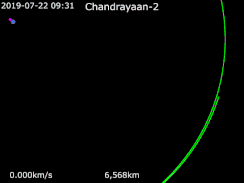
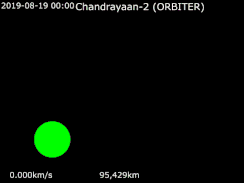
_around_Moon.gif)
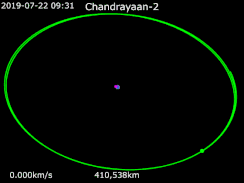

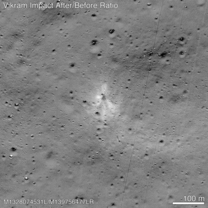
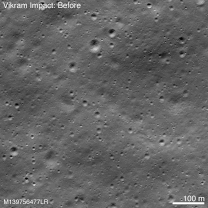
_at_ISTRAC%2C_Peenya_before_commencement_of_fourth_orbit_raising_burn_for_Chandrayaan-2.jpg)
